
Tampa is a city on the Gulf Coast of the U.S. state of Florida. Tampa's borders include the north shore of Tampa Bay and the east shore of Old Tampa Bay. Tampa is the largest city in the Tampa Bay area and the county seat of Hillsborough County. With an estimated population of 403,364 in 2023, Tampa is the 49th-most populous city in the country and the third-most populous city in Florida after Jacksonville and Miami.

A krewe is a social organization that stages parades and/or balls for the Carnival season. The term is best known for its association with Mardi Gras celebrations in New Orleans, but is also used in other Carnival celebrations throughout Louisiana and along the Gulf of Mexico, such as the Gasparilla Pirate Festival in Tampa, Florida, Springtime Tallahassee, and Krewe of Amalee in DeLand, Florida with the Mardi Gras on Mainstreet Parade as well as in La Crosse, Wisconsin and at the Saint Paul Winter Carnival.
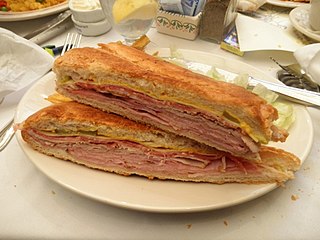
A Cuban sandwich is a variation of a ham and cheese sandwich that likely originated in cafes catering to Cuban workers in Tampa or Key West, two early Cuban immigrant communities in Florida centered on the cigar industry. Later on, Cuban exiles and expatriates brought it to Miami, where it is also very popular. The sandwich is made with ham, mojo, roasted pork, Swiss cheese, pickles, mustard, and sometimes salami on Cuban bread. Salami is included in Tampa, but is not usually included in South Florida.
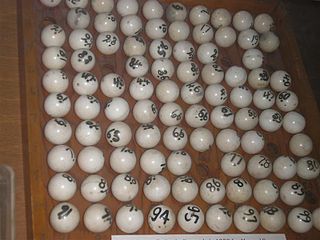
Bolita is a type of lottery which was popular in the latter 19th and early 20th centuries in Cuba and among Florida's working class Hispanic, Italian, and black population. In the basic bolita game, 100 small numbered balls are placed into a bag and mixed thoroughly, and bets are taken on which number will be drawn. Many variations on this theme were created. Bets were typically very small and sometimes sold well in advance, and the game could be rigged, by having extra balls of a given number or not including others at all. Other means of cheating included having certain balls filled with lead so they would sink to the bottom of the bag, or putting certain balls in ice beforehand so they would be cold and therefore easy for the selector to find by touch. Over time, Hispanics developed a name for each number in a system called La Charada or Las Charadas, creating a superstitious method for interpreting game outcomes or placing bets, many times in accordance with one's dreams the previous night.

Ybor City is a historic neighborhood just northeast of downtown Tampa, Florida, United States. It was founded in the 1880s by Vicente Martinez-Ybor and other cigar manufacturers and populated by thousands of immigrants, mainly from Cuba, Spain, and Italy. For the next 50 years, workers in Ybor City's cigar factories rolled hundreds of millions of cigars annually.

The Gasparilla Pirate Festival is a large parade and a host of related community events held in Tampa, Florida, United States, most years since 1904. The centerpiece of the festivities is the Parade of Pirates, which is framed as a friendly invasion by the crew of the mythical pirate José Gaspar, a popular figure in Florida folklore. The Parade of Pirates is often referred to as the Gasparilla Parade by locals, and the date of the event is known as Gasparilla Day.
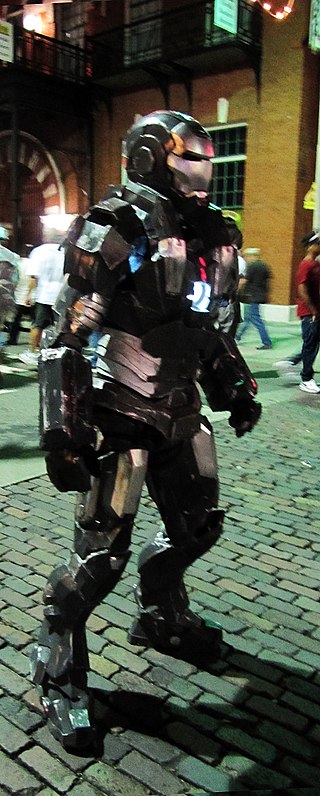
Guavaween was an annual Latin-flavored Halloween celebration which took place on the last Saturday of October in the historic neighborhood of Ybor City on Tampa, Florida. It was named after Tampa's nickname, "The Big Guava".
The modern history of Tampa, Florida, can be traced to the founding of Fort Brooke at the mouth of the Hillsborough River in today's downtown in 1824, soon after the United States had taken possession of Florida from Spain. The outpost brought a small population of civilians to the area, and the town of Tampa was first incorporated in 1855.

The Ybor City Historic District is a U.S. National Historic Landmark District located in Ybor City, Tampa, Florida. The district is bounded by 6th Avenue, 13th Street, 10th Avenue and 22nd Street, East Broadway between 13th and 22nd Streets. Ybor City contains a total of 956 historic buildings, including an unparalleled collection of architecture with Spanish-Cuban influence, as well as historic cigar factory buildings and associated infrastructure. The area was developed by businessman Vicente Martinez Ybor beginning in 1886, and was for a time the world's leading supplier of cigars.

El Centro Español de Tampa is a historic building in the Ybor City neighborhood of Tampa, in the U.S. state of Florida. Built as an ethnic and cultural clubhouse in 1912, the red brick structure situated at 1526–1536 East 7th Avenue is today part of a shopping and entertainment complex. It remains one of the few surviving structures specific to Spanish immigration to the United States during the late 19th and early 20th centuries, a legacy which garnered the Centro Español building recognition as a U.S. National Historic Landmark (NHL) on June 3, 1988. El Centro Español de Tampa is one of two individual structures within Hillsborough County to be so designated.

The Centro Asturiano is a historic site in Ybor City, Tampa, Florida, United States. Designed by Tampa-based architect M. Leo Elliott and located at 1913 Nebraska Avenue, the building served as a social club for immigrants and descendants of immigrants from Asturias, Spain. On July 24, 1974, it was added to the US National Register of Historic Places.
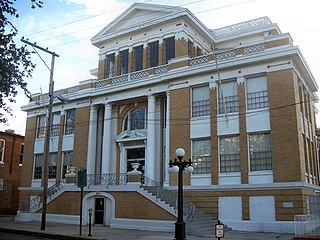
El Circulo Cubano de Tampa is an American historic building constructed in 1917 to serve as a gathering place for Cuban immigrants in Ybor City, Tampa, Florida. It was designed by Tampa architect M. Leo Elliott. It is located at Palm Avenue and 14th Street. On November 15, 1972, it was added to the U.S. National Register of Historic Places. On April 18, 2012, the AIA's Florida Chapter placed the building on its list of Florida Architecture: 100 Years. 100 Places as Cuban Club, Ybor City.

The Ybor Factory Building is a historic site in Tampa, Florida, United States located at 1911 North 13th Street. The main factory and its surrounding support buildings cover an entire city block between 8th Avenue and 9th Avenues and 13th and 14th Streets in the Ybor City Historic District section of the Ybor City neighborhood. C. E. Parcell is credited as the building's architect.
Charles Todd Lee, Jr., better known as Bud Lee, was a Florida based photojournalist and artist, known for his photograph of a boy wounded in the 1967 Newark riots.

Ybor City is a historic neighborhood that includes the Ybor City Historic District in Tampa, Florida. It is located just northeast of downtown Tampa and north of Port Tampa Bay. The neighborhood has distinct architectural, culinary, cultural, and historical legacy that reflects its multi-ethnic composition. It was unique in the American South as a prosperous manufacturing community built and populated almost entirely by immigrants.

The Big Guava is a nickname for Tampa, Florida, United States. It was coined in the 1970s by Steve Otto, long-time newspaper columnist for the Tampa Tribune and Tampa Times.
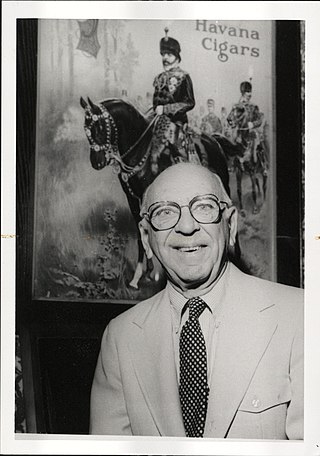
Anthony P. Pizzo (1912-1994) was a well-respected local historian and businessman, and was internationally recognized for his attempts to preserve the Italian American and Cuban American heritage and history of Tampa, Florida, and in particular that of his home neighborhood of Ybor City. From 1982 until his death in 1994, Pizzo was the official historian of Hillsborough County, and is author of several histories, most of which celebrate the unusual multicultural makeup of early Tampa. Pizzo also served as chairman of the Hillsborough County Historical Commission from 1968 to 1980, where he oversaw and was responsible for over eighty historical markers in Tampa and Ybor City.
The following is a timeline of the history of the city of Tampa in Hillsborough County, Florida, United States.

The Ries Brothers are a musical duo from Tampa, Florida, playing a mix of rock, blues, funk, and reggae. Older brother, Charlie, sings lead vocals while playing drums and keyboard bass. Younger brother, Kevin Jordan, plays guitar, provides background vocals, and co-writes many of their songs.